CHSUG 2003 - Youth Detention and Community Development Essay Analysis
VerifiedAdded on 2020/11/23
|10
|2581
|494
Essay
AI Summary
This essay delves into the multifaceted issue of youth detention, examining it through the lens of community development and critical social theories. It begins by defining youth detention and outlining the key community development and critical social theories, including empowerment theory and the Ford Foundation's role. The essay then explores how readings contribute to understanding youth detention and the importance of reading skills for those involved in the juvenile justice system. It applies critical community development theories, such as positive youth development and deterrence theory, to the context of youth detention. A significant portion of the essay highlights the significance of collaborative approaches, particularly the need for collaboration between juvenile justice and mental health systems, and discusses the role of local community organizations and detention centers. The essay concludes by summarizing the essential role of community development in supporting youth and promoting positive outcomes. The analysis incorporates various theories and real-world examples, including the Don Dale Youth Detention Centre in Australia.
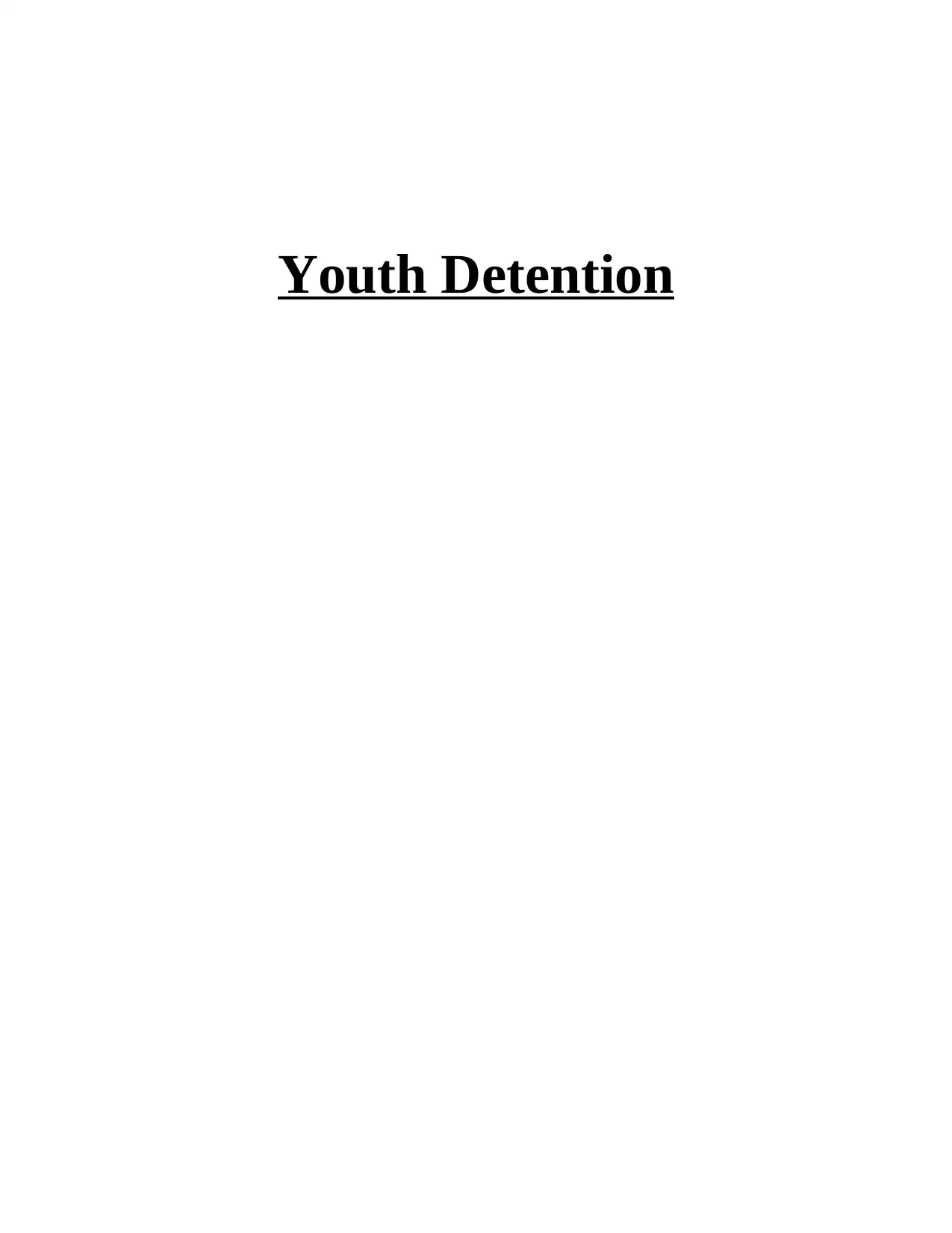
Youth Detention
Paraphrase This Document
Need a fresh take? Get an instant paraphrase of this document with our AI Paraphraser
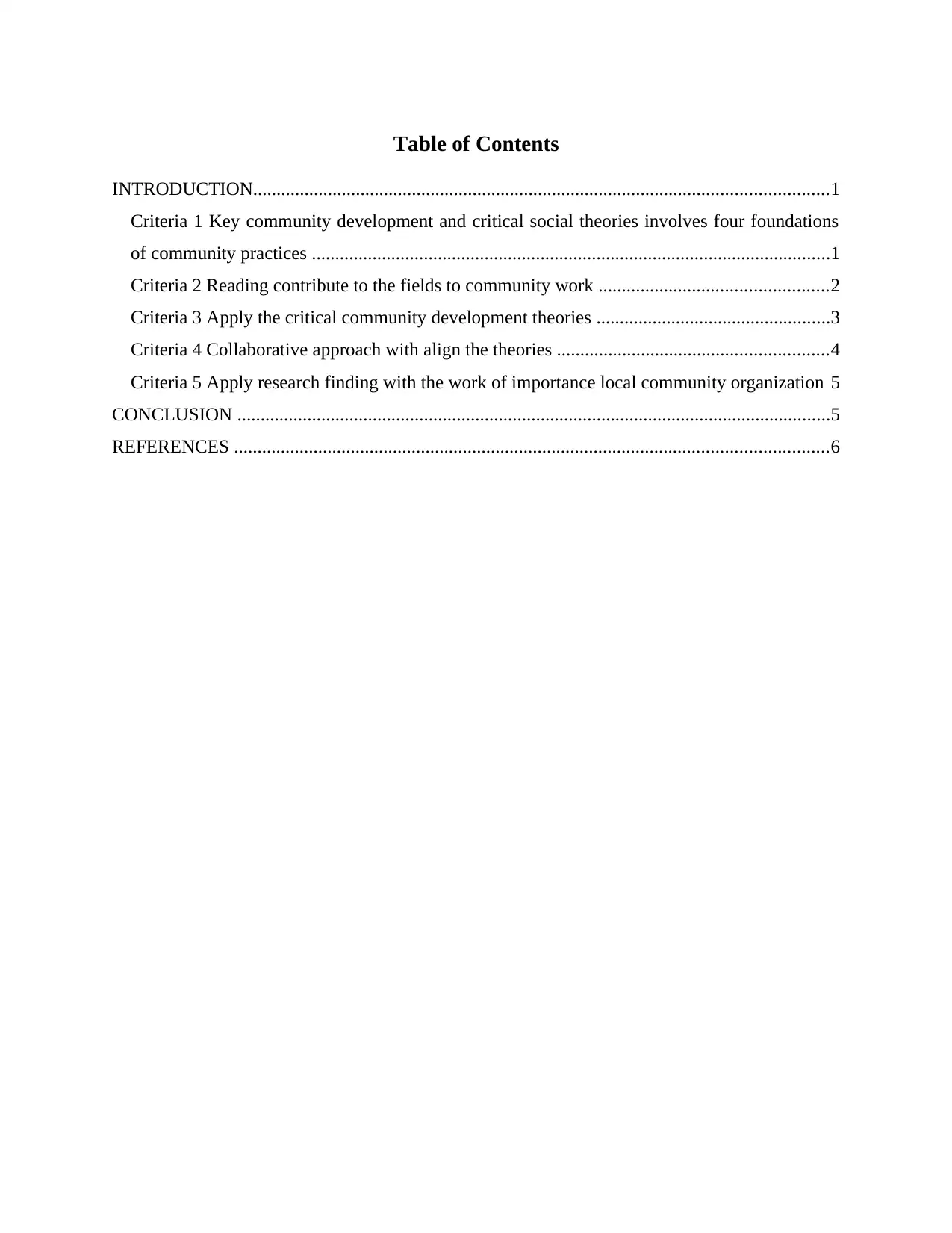
Table of Contents
INTRODUCTION...........................................................................................................................1
Criteria 1 Key community development and critical social theories involves four foundations
of community practices ...............................................................................................................1
Criteria 2 Reading contribute to the fields to community work .................................................2
Criteria 3 Apply the critical community development theories ..................................................3
Criteria 4 Collaborative approach with align the theories ..........................................................4
Criteria 5 Apply research finding with the work of importance local community organization 5
CONCLUSION ...............................................................................................................................5
REFERENCES ...............................................................................................................................6
INTRODUCTION...........................................................................................................................1
Criteria 1 Key community development and critical social theories involves four foundations
of community practices ...............................................................................................................1
Criteria 2 Reading contribute to the fields to community work .................................................2
Criteria 3 Apply the critical community development theories ..................................................3
Criteria 4 Collaborative approach with align the theories ..........................................................4
Criteria 5 Apply research finding with the work of importance local community organization 5
CONCLUSION ...............................................................................................................................5
REFERENCES ...............................................................................................................................6

⊘ This is a preview!⊘
Do you want full access?
Subscribe today to unlock all pages.

Trusted by 1+ million students worldwide
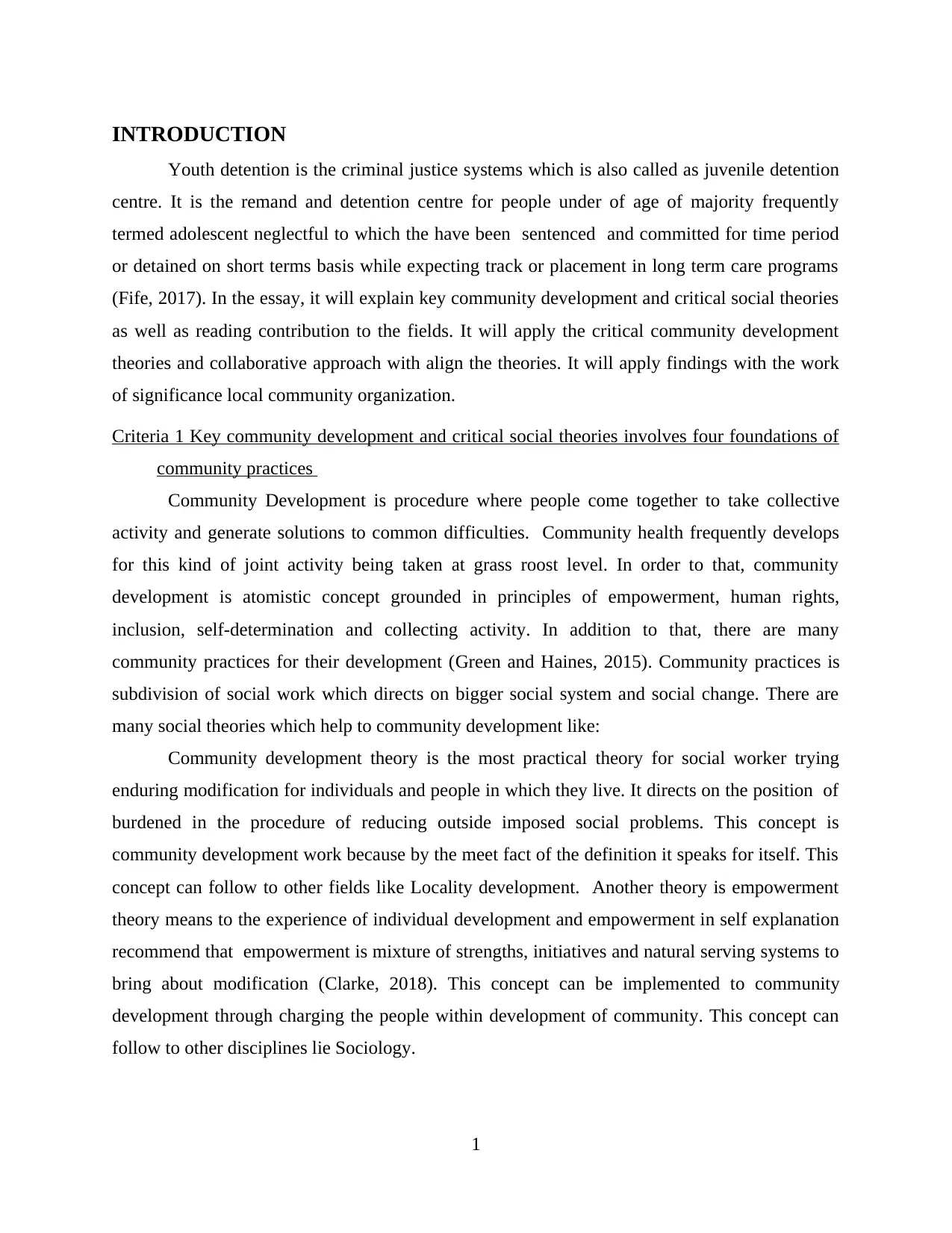
INTRODUCTION
Youth detention is the criminal justice systems which is also called as juvenile detention
centre. It is the remand and detention centre for people under of age of majority frequently
termed adolescent neglectful to which the have been sentenced and committed for time period
or detained on short terms basis while expecting track or placement in long term care programs
(Fife, 2017). In the essay, it will explain key community development and critical social theories
as well as reading contribution to the fields. It will apply the critical community development
theories and collaborative approach with align the theories. It will apply findings with the work
of significance local community organization.
Criteria 1 Key community development and critical social theories involves four foundations of
community practices
Community Development is procedure where people come together to take collective
activity and generate solutions to common difficulties. Community health frequently develops
for this kind of joint activity being taken at grass roost level. In order to that, community
development is atomistic concept grounded in principles of empowerment, human rights,
inclusion, self-determination and collecting activity. In addition to that, there are many
community practices for their development (Green and Haines, 2015). Community practices is
subdivision of social work which directs on bigger social system and social change. There are
many social theories which help to community development like:
Community development theory is the most practical theory for social worker trying
enduring modification for individuals and people in which they live. It directs on the position of
burdened in the procedure of reducing outside imposed social problems. This concept is
community development work because by the meet fact of the definition it speaks for itself. This
concept can follow to other fields like Locality development. Another theory is empowerment
theory means to the experience of individual development and empowerment in self explanation
recommend that empowerment is mixture of strengths, initiatives and natural serving systems to
bring about modification (Clarke, 2018). This concept can be implemented to community
development through charging the people within development of community. This concept can
follow to other disciplines lie Sociology.
1
Youth detention is the criminal justice systems which is also called as juvenile detention
centre. It is the remand and detention centre for people under of age of majority frequently
termed adolescent neglectful to which the have been sentenced and committed for time period
or detained on short terms basis while expecting track or placement in long term care programs
(Fife, 2017). In the essay, it will explain key community development and critical social theories
as well as reading contribution to the fields. It will apply the critical community development
theories and collaborative approach with align the theories. It will apply findings with the work
of significance local community organization.
Criteria 1 Key community development and critical social theories involves four foundations of
community practices
Community Development is procedure where people come together to take collective
activity and generate solutions to common difficulties. Community health frequently develops
for this kind of joint activity being taken at grass roost level. In order to that, community
development is atomistic concept grounded in principles of empowerment, human rights,
inclusion, self-determination and collecting activity. In addition to that, there are many
community practices for their development (Green and Haines, 2015). Community practices is
subdivision of social work which directs on bigger social system and social change. There are
many social theories which help to community development like:
Community development theory is the most practical theory for social worker trying
enduring modification for individuals and people in which they live. It directs on the position of
burdened in the procedure of reducing outside imposed social problems. This concept is
community development work because by the meet fact of the definition it speaks for itself. This
concept can follow to other fields like Locality development. Another theory is empowerment
theory means to the experience of individual development and empowerment in self explanation
recommend that empowerment is mixture of strengths, initiatives and natural serving systems to
bring about modification (Clarke, 2018). This concept can be implemented to community
development through charging the people within development of community. This concept can
follow to other disciplines lie Sociology.
1
Paraphrase This Document
Need a fresh take? Get an instant paraphrase of this document with our AI Paraphraser
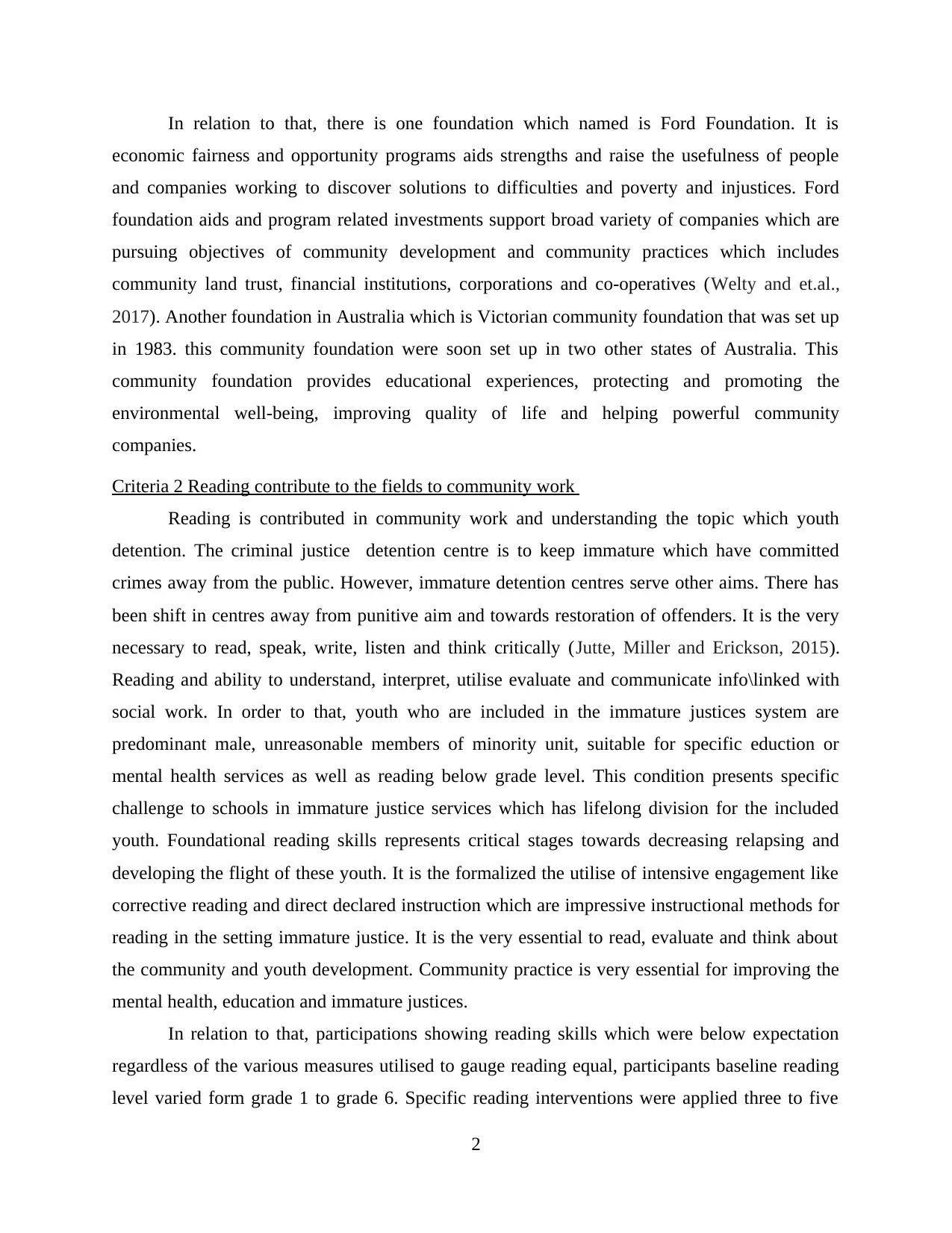
In relation to that, there is one foundation which named is Ford Foundation. It is
economic fairness and opportunity programs aids strengths and raise the usefulness of people
and companies working to discover solutions to difficulties and poverty and injustices. Ford
foundation aids and program related investments support broad variety of companies which are
pursuing objectives of community development and community practices which includes
community land trust, financial institutions, corporations and co-operatives (Welty and et.al.,
2017). Another foundation in Australia which is Victorian community foundation that was set up
in 1983. this community foundation were soon set up in two other states of Australia. This
community foundation provides educational experiences, protecting and promoting the
environmental well-being, improving quality of life and helping powerful community
companies.
Criteria 2 Reading contribute to the fields to community work
Reading is contributed in community work and understanding the topic which youth
detention. The criminal justice detention centre is to keep immature which have committed
crimes away from the public. However, immature detention centres serve other aims. There has
been shift in centres away from punitive aim and towards restoration of offenders. It is the very
necessary to read, speak, write, listen and think critically (Jutte, Miller and Erickson, 2015).
Reading and ability to understand, interpret, utilise evaluate and communicate info\linked with
social work. In order to that, youth who are included in the immature justices system are
predominant male, unreasonable members of minority unit, suitable for specific eduction or
mental health services as well as reading below grade level. This condition presents specific
challenge to schools in immature justice services which has lifelong division for the included
youth. Foundational reading skills represents critical stages towards decreasing relapsing and
developing the flight of these youth. It is the formalized the utilise of intensive engagement like
corrective reading and direct declared instruction which are impressive instructional methods for
reading in the setting immature justice. It is the very essential to read, evaluate and think about
the community and youth development. Community practice is very essential for improving the
mental health, education and immature justices.
In relation to that, participations showing reading skills which were below expectation
regardless of the various measures utilised to gauge reading equal, participants baseline reading
level varied form grade 1 to grade 6. Specific reading interventions were applied three to five
2
economic fairness and opportunity programs aids strengths and raise the usefulness of people
and companies working to discover solutions to difficulties and poverty and injustices. Ford
foundation aids and program related investments support broad variety of companies which are
pursuing objectives of community development and community practices which includes
community land trust, financial institutions, corporations and co-operatives (Welty and et.al.,
2017). Another foundation in Australia which is Victorian community foundation that was set up
in 1983. this community foundation were soon set up in two other states of Australia. This
community foundation provides educational experiences, protecting and promoting the
environmental well-being, improving quality of life and helping powerful community
companies.
Criteria 2 Reading contribute to the fields to community work
Reading is contributed in community work and understanding the topic which youth
detention. The criminal justice detention centre is to keep immature which have committed
crimes away from the public. However, immature detention centres serve other aims. There has
been shift in centres away from punitive aim and towards restoration of offenders. It is the very
necessary to read, speak, write, listen and think critically (Jutte, Miller and Erickson, 2015).
Reading and ability to understand, interpret, utilise evaluate and communicate info\linked with
social work. In order to that, youth who are included in the immature justices system are
predominant male, unreasonable members of minority unit, suitable for specific eduction or
mental health services as well as reading below grade level. This condition presents specific
challenge to schools in immature justice services which has lifelong division for the included
youth. Foundational reading skills represents critical stages towards decreasing relapsing and
developing the flight of these youth. It is the formalized the utilise of intensive engagement like
corrective reading and direct declared instruction which are impressive instructional methods for
reading in the setting immature justice. It is the very essential to read, evaluate and think about
the community and youth development. Community practice is very essential for improving the
mental health, education and immature justices.
In relation to that, participations showing reading skills which were below expectation
regardless of the various measures utilised to gauge reading equal, participants baseline reading
level varied form grade 1 to grade 6. Specific reading interventions were applied three to five
2
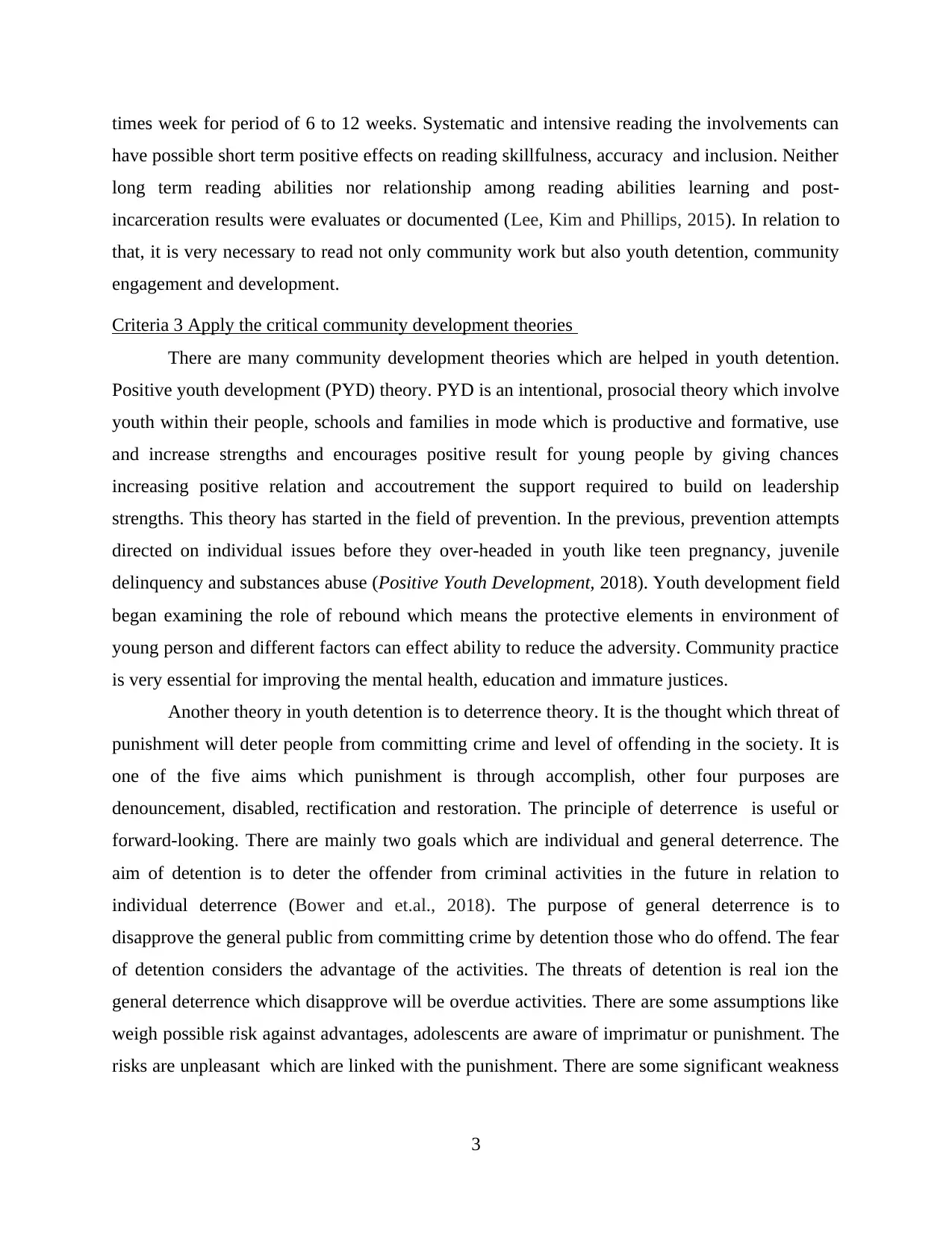
times week for period of 6 to 12 weeks. Systematic and intensive reading the involvements can
have possible short term positive effects on reading skillfulness, accuracy and inclusion. Neither
long term reading abilities nor relationship among reading abilities learning and post-
incarceration results were evaluates or documented (Lee, Kim and Phillips, 2015). In relation to
that, it is very necessary to read not only community work but also youth detention, community
engagement and development.
Criteria 3 Apply the critical community development theories
There are many community development theories which are helped in youth detention.
Positive youth development (PYD) theory. PYD is an intentional, prosocial theory which involve
youth within their people, schools and families in mode which is productive and formative, use
and increase strengths and encourages positive result for young people by giving chances
increasing positive relation and accoutrement the support required to build on leadership
strengths. This theory has started in the field of prevention. In the previous, prevention attempts
directed on individual issues before they over-headed in youth like teen pregnancy, juvenile
delinquency and substances abuse (Positive Youth Development, 2018). Youth development field
began examining the role of rebound which means the protective elements in environment of
young person and different factors can effect ability to reduce the adversity. Community practice
is very essential for improving the mental health, education and immature justices.
Another theory in youth detention is to deterrence theory. It is the thought which threat of
punishment will deter people from committing crime and level of offending in the society. It is
one of the five aims which punishment is through accomplish, other four purposes are
denouncement, disabled, rectification and restoration. The principle of deterrence is useful or
forward-looking. There are mainly two goals which are individual and general deterrence. The
aim of detention is to deter the offender from criminal activities in the future in relation to
individual deterrence (Bower and et.al., 2018). The purpose of general deterrence is to
disapprove the general public from committing crime by detention those who do offend. The fear
of detention considers the advantage of the activities. The threats of detention is real ion the
general deterrence which disapprove will be overdue activities. There are some assumptions like
weigh possible risk against advantages, adolescents are aware of imprimatur or punishment. The
risks are unpleasant which are linked with the punishment. There are some significant weakness
3
have possible short term positive effects on reading skillfulness, accuracy and inclusion. Neither
long term reading abilities nor relationship among reading abilities learning and post-
incarceration results were evaluates or documented (Lee, Kim and Phillips, 2015). In relation to
that, it is very necessary to read not only community work but also youth detention, community
engagement and development.
Criteria 3 Apply the critical community development theories
There are many community development theories which are helped in youth detention.
Positive youth development (PYD) theory. PYD is an intentional, prosocial theory which involve
youth within their people, schools and families in mode which is productive and formative, use
and increase strengths and encourages positive result for young people by giving chances
increasing positive relation and accoutrement the support required to build on leadership
strengths. This theory has started in the field of prevention. In the previous, prevention attempts
directed on individual issues before they over-headed in youth like teen pregnancy, juvenile
delinquency and substances abuse (Positive Youth Development, 2018). Youth development field
began examining the role of rebound which means the protective elements in environment of
young person and different factors can effect ability to reduce the adversity. Community practice
is very essential for improving the mental health, education and immature justices.
Another theory in youth detention is to deterrence theory. It is the thought which threat of
punishment will deter people from committing crime and level of offending in the society. It is
one of the five aims which punishment is through accomplish, other four purposes are
denouncement, disabled, rectification and restoration. The principle of deterrence is useful or
forward-looking. There are mainly two goals which are individual and general deterrence. The
aim of detention is to deter the offender from criminal activities in the future in relation to
individual deterrence (Bower and et.al., 2018). The purpose of general deterrence is to
disapprove the general public from committing crime by detention those who do offend. The fear
of detention considers the advantage of the activities. The threats of detention is real ion the
general deterrence which disapprove will be overdue activities. There are some assumptions like
weigh possible risk against advantages, adolescents are aware of imprimatur or punishment. The
risks are unpleasant which are linked with the punishment. There are some significant weakness
3
⊘ This is a preview!⊘
Do you want full access?
Subscribe today to unlock all pages.

Trusted by 1+ million students worldwide
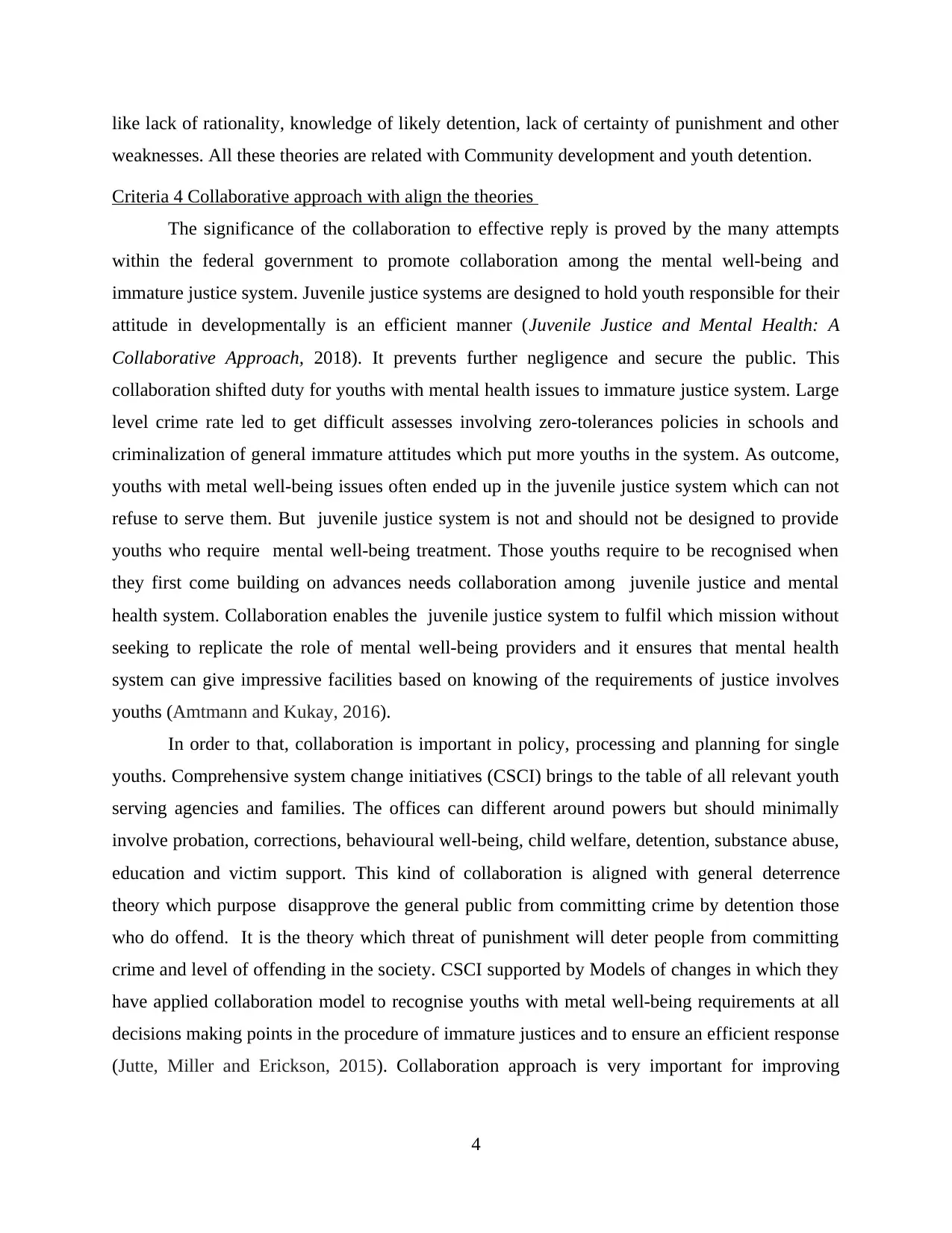
like lack of rationality, knowledge of likely detention, lack of certainty of punishment and other
weaknesses. All these theories are related with Community development and youth detention.
Criteria 4 Collaborative approach with align the theories
The significance of the collaboration to effective reply is proved by the many attempts
within the federal government to promote collaboration among the mental well-being and
immature justice system. Juvenile justice systems are designed to hold youth responsible for their
attitude in developmentally is an efficient manner (Juvenile Justice and Mental Health: A
Collaborative Approach, 2018). It prevents further negligence and secure the public. This
collaboration shifted duty for youths with mental health issues to immature justice system. Large
level crime rate led to get difficult assesses involving zero-tolerances policies in schools and
criminalization of general immature attitudes which put more youths in the system. As outcome,
youths with metal well-being issues often ended up in the juvenile justice system which can not
refuse to serve them. But juvenile justice system is not and should not be designed to provide
youths who require mental well-being treatment. Those youths require to be recognised when
they first come building on advances needs collaboration among juvenile justice and mental
health system. Collaboration enables the juvenile justice system to fulfil which mission without
seeking to replicate the role of mental well-being providers and it ensures that mental health
system can give impressive facilities based on knowing of the requirements of justice involves
youths (Amtmann and Kukay, 2016).
In order to that, collaboration is important in policy, processing and planning for single
youths. Comprehensive system change initiatives (CSCI) brings to the table of all relevant youth
serving agencies and families. The offices can different around powers but should minimally
involve probation, corrections, behavioural well-being, child welfare, detention, substance abuse,
education and victim support. This kind of collaboration is aligned with general deterrence
theory which purpose disapprove the general public from committing crime by detention those
who do offend. It is the theory which threat of punishment will deter people from committing
crime and level of offending in the society. CSCI supported by Models of changes in which they
have applied collaboration model to recognise youths with metal well-being requirements at all
decisions making points in the procedure of immature justices and to ensure an efficient response
(Jutte, Miller and Erickson, 2015). Collaboration approach is very important for improving
4
weaknesses. All these theories are related with Community development and youth detention.
Criteria 4 Collaborative approach with align the theories
The significance of the collaboration to effective reply is proved by the many attempts
within the federal government to promote collaboration among the mental well-being and
immature justice system. Juvenile justice systems are designed to hold youth responsible for their
attitude in developmentally is an efficient manner (Juvenile Justice and Mental Health: A
Collaborative Approach, 2018). It prevents further negligence and secure the public. This
collaboration shifted duty for youths with mental health issues to immature justice system. Large
level crime rate led to get difficult assesses involving zero-tolerances policies in schools and
criminalization of general immature attitudes which put more youths in the system. As outcome,
youths with metal well-being issues often ended up in the juvenile justice system which can not
refuse to serve them. But juvenile justice system is not and should not be designed to provide
youths who require mental well-being treatment. Those youths require to be recognised when
they first come building on advances needs collaboration among juvenile justice and mental
health system. Collaboration enables the juvenile justice system to fulfil which mission without
seeking to replicate the role of mental well-being providers and it ensures that mental health
system can give impressive facilities based on knowing of the requirements of justice involves
youths (Amtmann and Kukay, 2016).
In order to that, collaboration is important in policy, processing and planning for single
youths. Comprehensive system change initiatives (CSCI) brings to the table of all relevant youth
serving agencies and families. The offices can different around powers but should minimally
involve probation, corrections, behavioural well-being, child welfare, detention, substance abuse,
education and victim support. This kind of collaboration is aligned with general deterrence
theory which purpose disapprove the general public from committing crime by detention those
who do offend. It is the theory which threat of punishment will deter people from committing
crime and level of offending in the society. CSCI supported by Models of changes in which they
have applied collaboration model to recognise youths with metal well-being requirements at all
decisions making points in the procedure of immature justices and to ensure an efficient response
(Jutte, Miller and Erickson, 2015). Collaboration approach is very important for improving
4
Paraphrase This Document
Need a fresh take? Get an instant paraphrase of this document with our AI Paraphraser
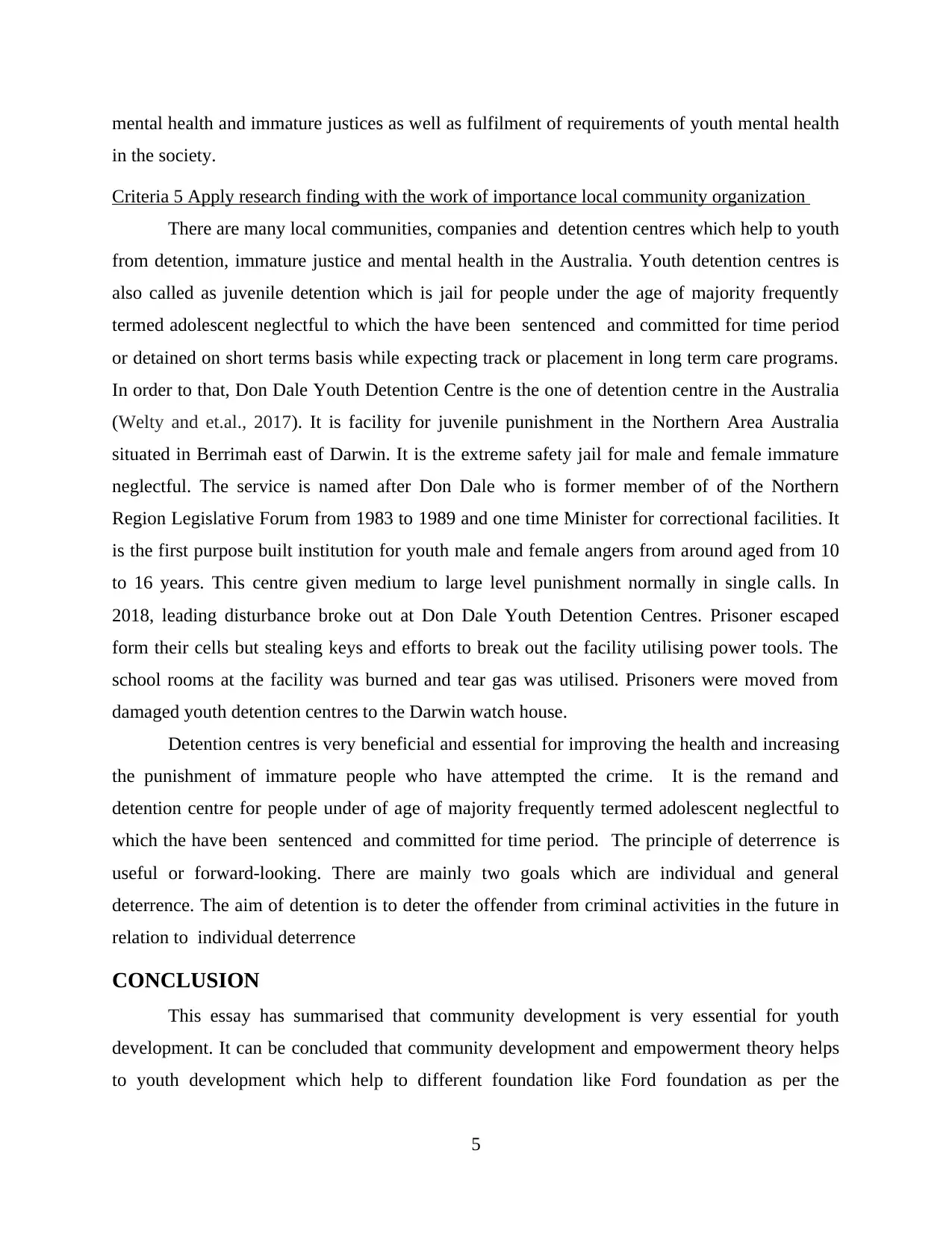
mental health and immature justices as well as fulfilment of requirements of youth mental health
in the society.
Criteria 5 Apply research finding with the work of importance local community organization
There are many local communities, companies and detention centres which help to youth
from detention, immature justice and mental health in the Australia. Youth detention centres is
also called as juvenile detention which is jail for people under the age of majority frequently
termed adolescent neglectful to which the have been sentenced and committed for time period
or detained on short terms basis while expecting track or placement in long term care programs.
In order to that, Don Dale Youth Detention Centre is the one of detention centre in the Australia
(Welty and et.al., 2017). It is facility for juvenile punishment in the Northern Area Australia
situated in Berrimah east of Darwin. It is the extreme safety jail for male and female immature
neglectful. The service is named after Don Dale who is former member of of the Northern
Region Legislative Forum from 1983 to 1989 and one time Minister for correctional facilities. It
is the first purpose built institution for youth male and female angers from around aged from 10
to 16 years. This centre given medium to large level punishment normally in single calls. In
2018, leading disturbance broke out at Don Dale Youth Detention Centres. Prisoner escaped
form their cells but stealing keys and efforts to break out the facility utilising power tools. The
school rooms at the facility was burned and tear gas was utilised. Prisoners were moved from
damaged youth detention centres to the Darwin watch house.
Detention centres is very beneficial and essential for improving the health and increasing
the punishment of immature people who have attempted the crime. It is the remand and
detention centre for people under of age of majority frequently termed adolescent neglectful to
which the have been sentenced and committed for time period. The principle of deterrence is
useful or forward-looking. There are mainly two goals which are individual and general
deterrence. The aim of detention is to deter the offender from criminal activities in the future in
relation to individual deterrence
CONCLUSION
This essay has summarised that community development is very essential for youth
development. It can be concluded that community development and empowerment theory helps
to youth development which help to different foundation like Ford foundation as per the
5
in the society.
Criteria 5 Apply research finding with the work of importance local community organization
There are many local communities, companies and detention centres which help to youth
from detention, immature justice and mental health in the Australia. Youth detention centres is
also called as juvenile detention which is jail for people under the age of majority frequently
termed adolescent neglectful to which the have been sentenced and committed for time period
or detained on short terms basis while expecting track or placement in long term care programs.
In order to that, Don Dale Youth Detention Centre is the one of detention centre in the Australia
(Welty and et.al., 2017). It is facility for juvenile punishment in the Northern Area Australia
situated in Berrimah east of Darwin. It is the extreme safety jail for male and female immature
neglectful. The service is named after Don Dale who is former member of of the Northern
Region Legislative Forum from 1983 to 1989 and one time Minister for correctional facilities. It
is the first purpose built institution for youth male and female angers from around aged from 10
to 16 years. This centre given medium to large level punishment normally in single calls. In
2018, leading disturbance broke out at Don Dale Youth Detention Centres. Prisoner escaped
form their cells but stealing keys and efforts to break out the facility utilising power tools. The
school rooms at the facility was burned and tear gas was utilised. Prisoners were moved from
damaged youth detention centres to the Darwin watch house.
Detention centres is very beneficial and essential for improving the health and increasing
the punishment of immature people who have attempted the crime. It is the remand and
detention centre for people under of age of majority frequently termed adolescent neglectful to
which the have been sentenced and committed for time period. The principle of deterrence is
useful or forward-looking. There are mainly two goals which are individual and general
deterrence. The aim of detention is to deter the offender from criminal activities in the future in
relation to individual deterrence
CONCLUSION
This essay has summarised that community development is very essential for youth
development. It can be concluded that community development and empowerment theory helps
to youth development which help to different foundation like Ford foundation as per the
5
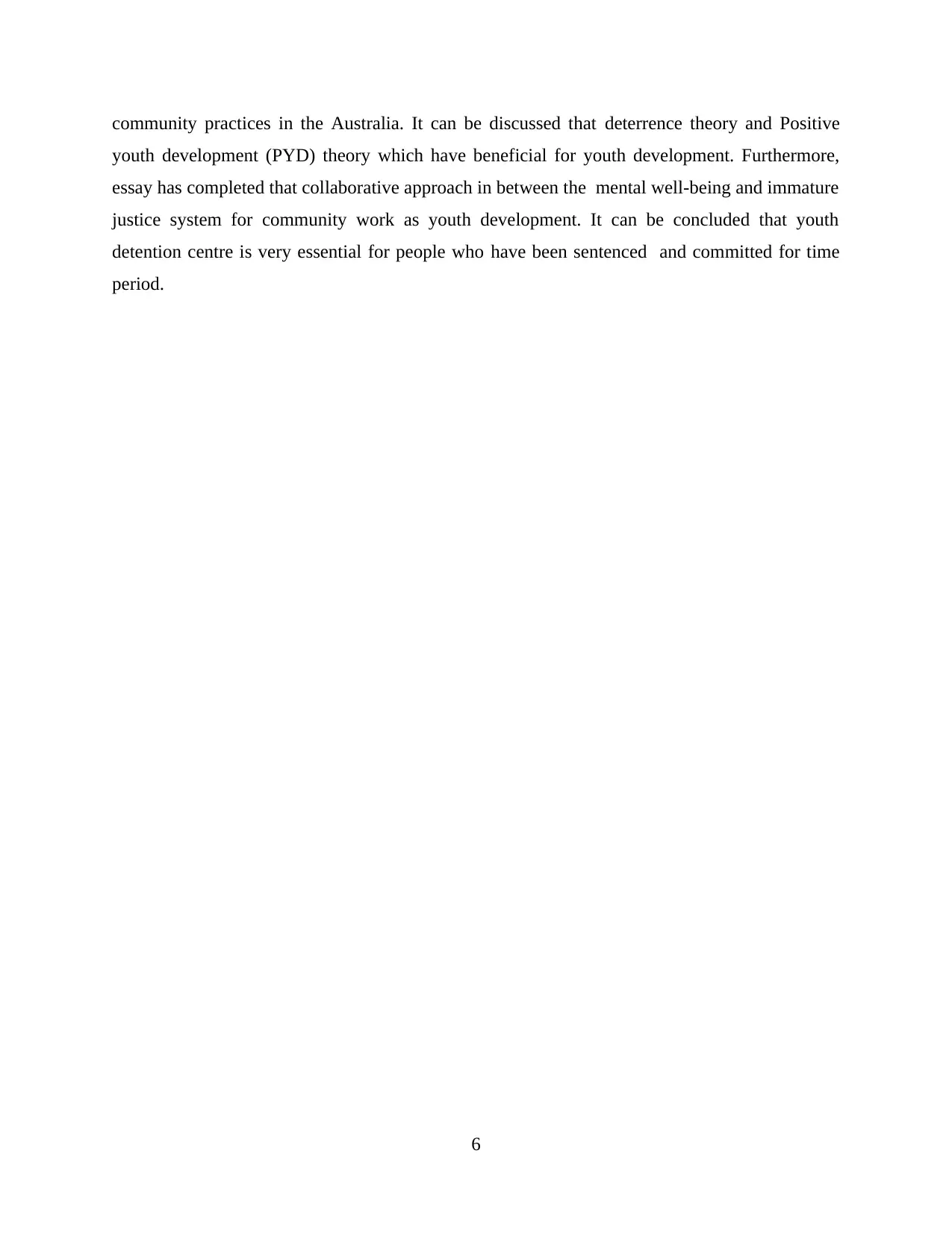
community practices in the Australia. It can be discussed that deterrence theory and Positive
youth development (PYD) theory which have beneficial for youth development. Furthermore,
essay has completed that collaborative approach in between the mental well-being and immature
justice system for community work as youth development. It can be concluded that youth
detention centre is very essential for people who have been sentenced and committed for time
period.
6
youth development (PYD) theory which have beneficial for youth development. Furthermore,
essay has completed that collaborative approach in between the mental well-being and immature
justice system for community work as youth development. It can be concluded that youth
detention centre is very essential for people who have been sentenced and committed for time
period.
6
⊘ This is a preview!⊘
Do you want full access?
Subscribe today to unlock all pages.

Trusted by 1+ million students worldwide
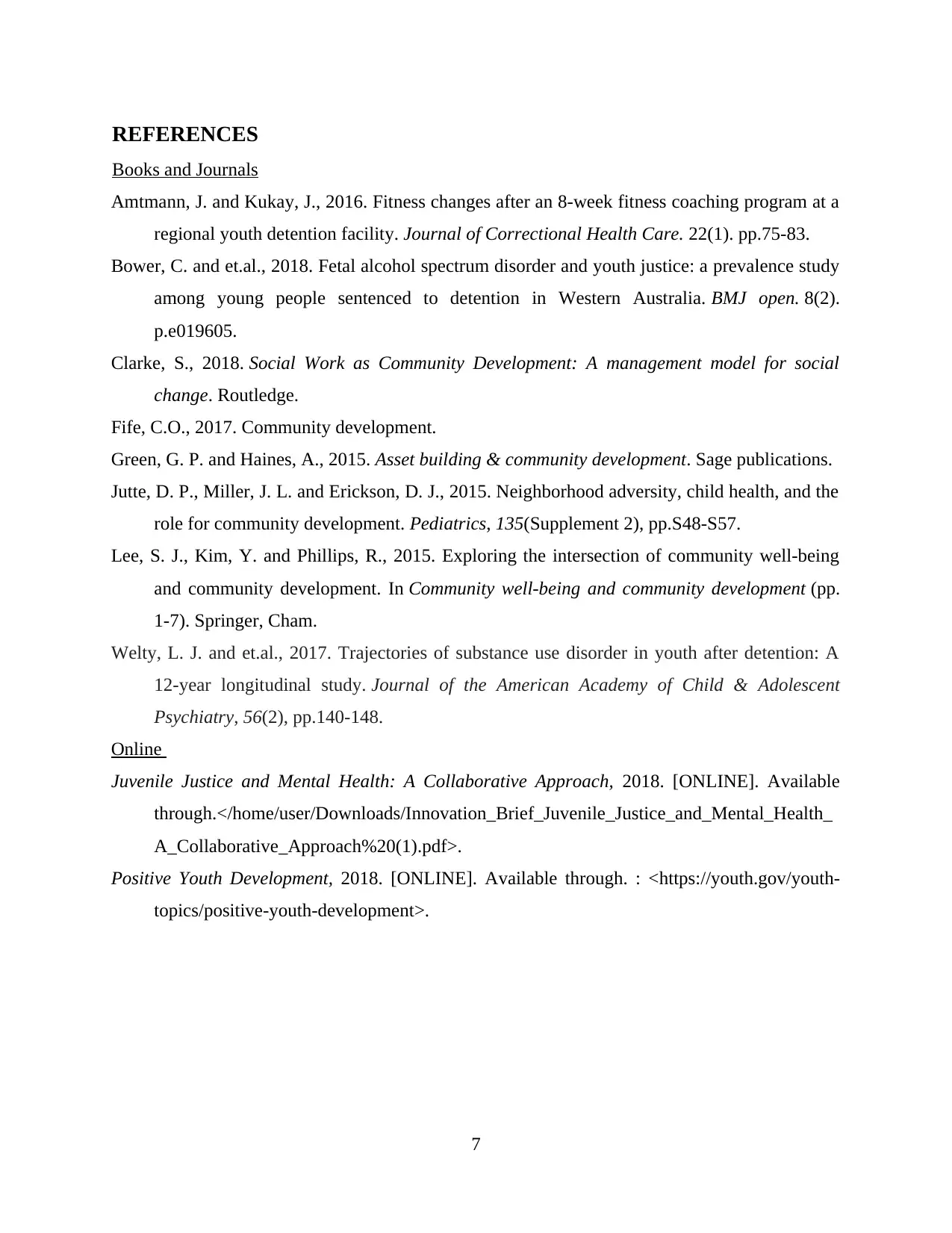
REFERENCES
Books and Journals
Amtmann, J. and Kukay, J., 2016. Fitness changes after an 8-week fitness coaching program at a
regional youth detention facility. Journal of Correctional Health Care. 22(1). pp.75-83.
Bower, C. and et.al., 2018. Fetal alcohol spectrum disorder and youth justice: a prevalence study
among young people sentenced to detention in Western Australia. BMJ open. 8(2).
p.e019605.
Clarke, S., 2018. Social Work as Community Development: A management model for social
change. Routledge.
Fife, C.O., 2017. Community development.
Green, G. P. and Haines, A., 2015. Asset building & community development. Sage publications.
Jutte, D. P., Miller, J. L. and Erickson, D. J., 2015. Neighborhood adversity, child health, and the
role for community development. Pediatrics, 135(Supplement 2), pp.S48-S57.
Lee, S. J., Kim, Y. and Phillips, R., 2015. Exploring the intersection of community well-being
and community development. In Community well-being and community development (pp.
1-7). Springer, Cham.
Welty, L. J. and et.al., 2017. Trajectories of substance use disorder in youth after detention: A
12-year longitudinal study. Journal of the American Academy of Child & Adolescent
Psychiatry, 56(2), pp.140-148.
Online
Juvenile Justice and Mental Health: A Collaborative Approach, 2018. [ONLINE]. Available
through.</home/user/Downloads/Innovation_Brief_Juvenile_Justice_and_Mental_Health_
A_Collaborative_Approach%20(1).pdf>.
Positive Youth Development, 2018. [ONLINE]. Available through. : <https://youth.gov/youth-
topics/positive-youth-development>.
7
Books and Journals
Amtmann, J. and Kukay, J., 2016. Fitness changes after an 8-week fitness coaching program at a
regional youth detention facility. Journal of Correctional Health Care. 22(1). pp.75-83.
Bower, C. and et.al., 2018. Fetal alcohol spectrum disorder and youth justice: a prevalence study
among young people sentenced to detention in Western Australia. BMJ open. 8(2).
p.e019605.
Clarke, S., 2018. Social Work as Community Development: A management model for social
change. Routledge.
Fife, C.O., 2017. Community development.
Green, G. P. and Haines, A., 2015. Asset building & community development. Sage publications.
Jutte, D. P., Miller, J. L. and Erickson, D. J., 2015. Neighborhood adversity, child health, and the
role for community development. Pediatrics, 135(Supplement 2), pp.S48-S57.
Lee, S. J., Kim, Y. and Phillips, R., 2015. Exploring the intersection of community well-being
and community development. In Community well-being and community development (pp.
1-7). Springer, Cham.
Welty, L. J. and et.al., 2017. Trajectories of substance use disorder in youth after detention: A
12-year longitudinal study. Journal of the American Academy of Child & Adolescent
Psychiatry, 56(2), pp.140-148.
Online
Juvenile Justice and Mental Health: A Collaborative Approach, 2018. [ONLINE]. Available
through.</home/user/Downloads/Innovation_Brief_Juvenile_Justice_and_Mental_Health_
A_Collaborative_Approach%20(1).pdf>.
Positive Youth Development, 2018. [ONLINE]. Available through. : <https://youth.gov/youth-
topics/positive-youth-development>.
7
1 out of 10
Related Documents
Your All-in-One AI-Powered Toolkit for Academic Success.
+13062052269
info@desklib.com
Available 24*7 on WhatsApp / Email
![[object Object]](/_next/static/media/star-bottom.7253800d.svg)
Unlock your academic potential
Copyright © 2020–2025 A2Z Services. All Rights Reserved. Developed and managed by ZUCOL.





